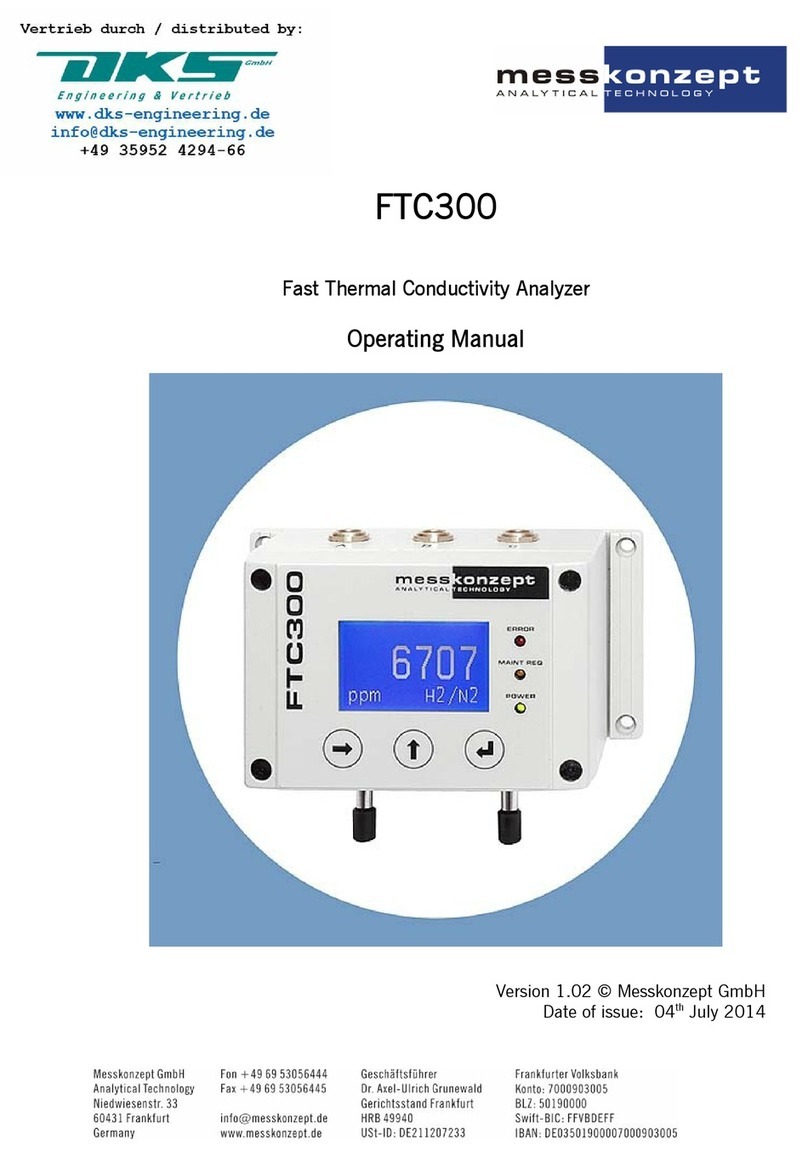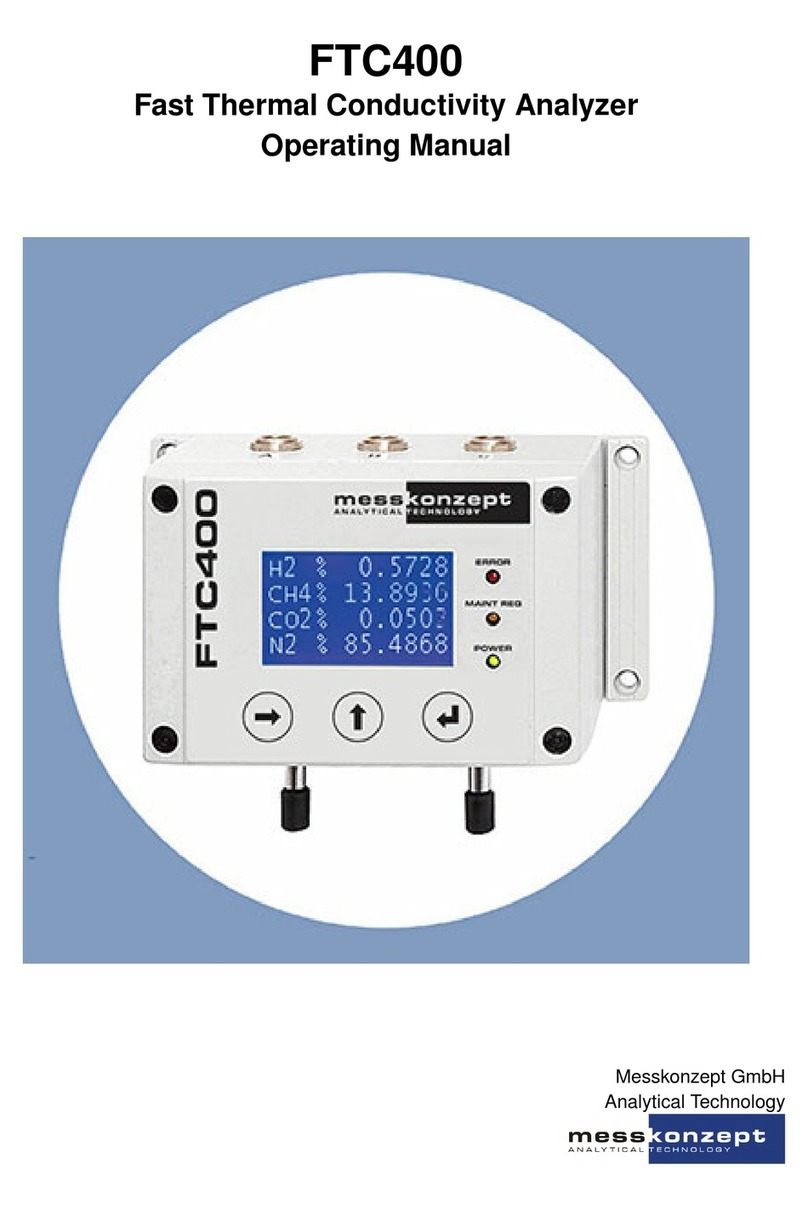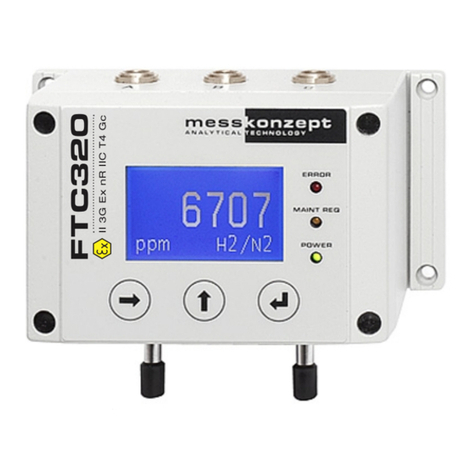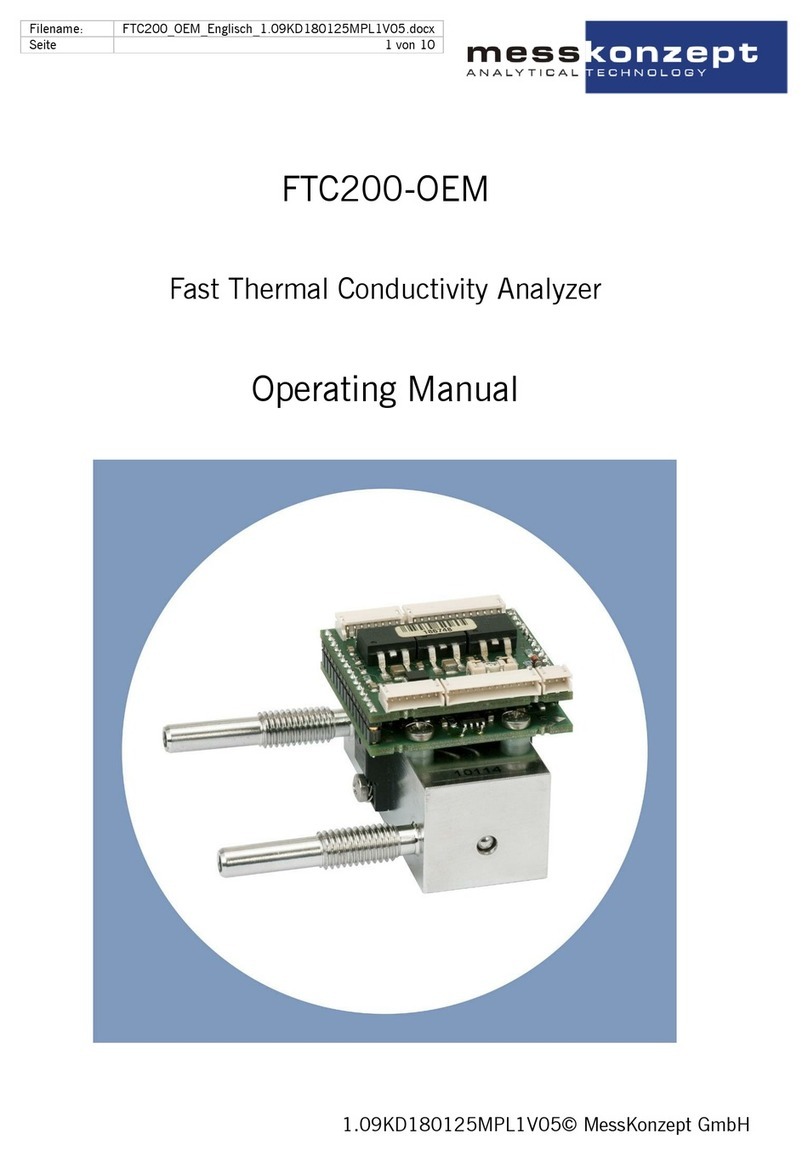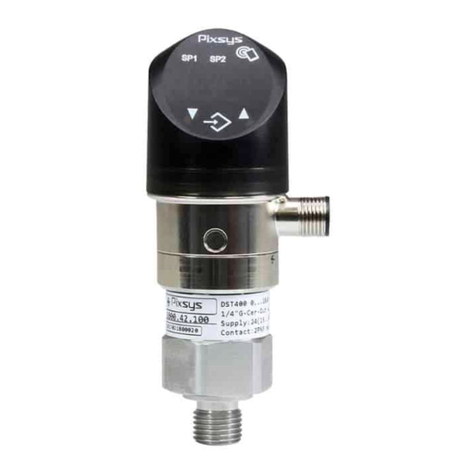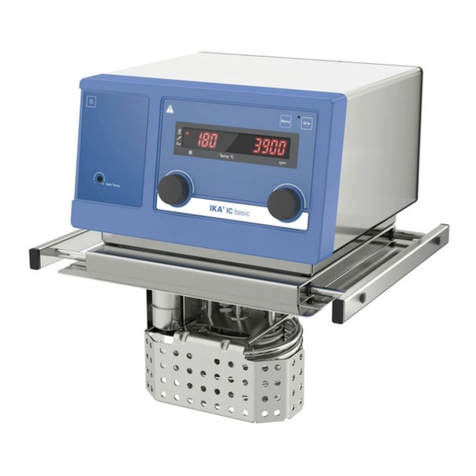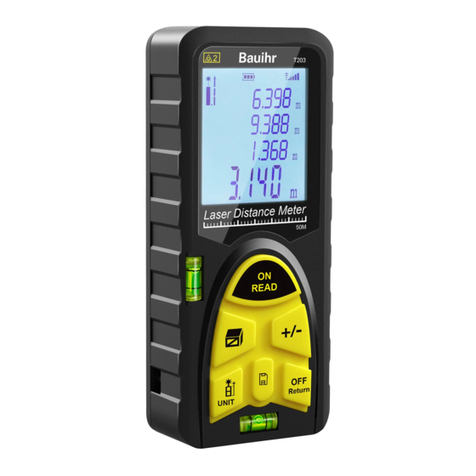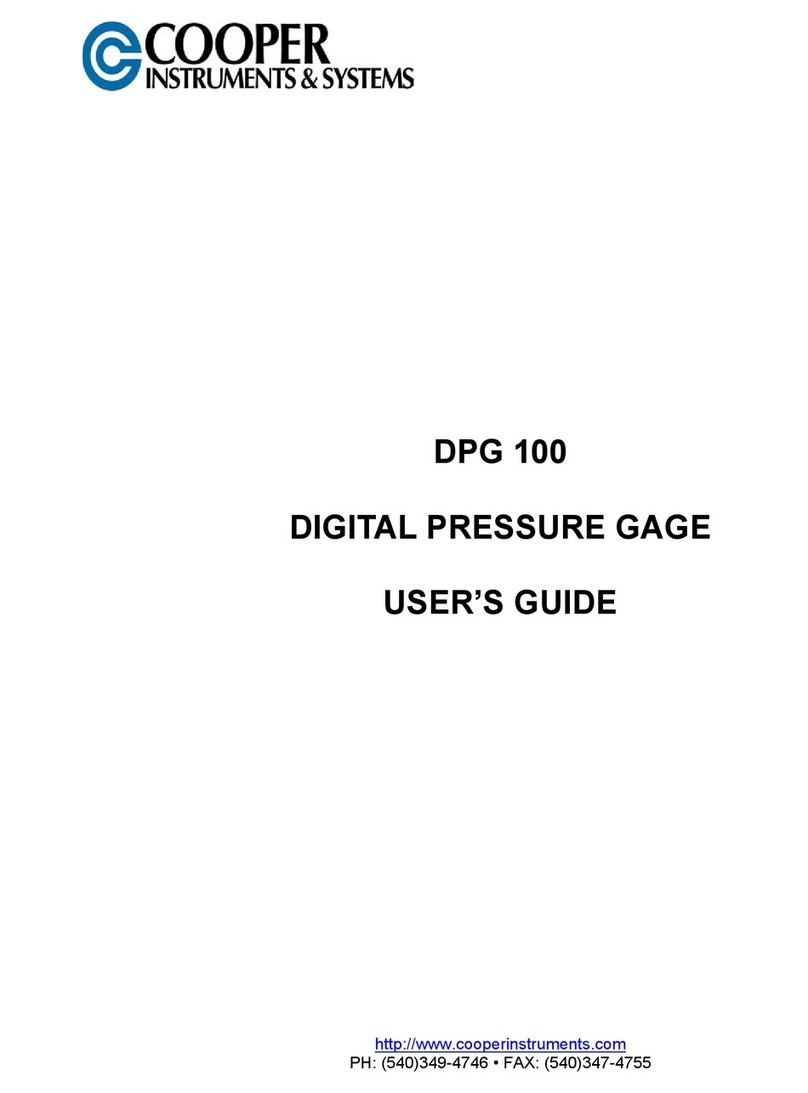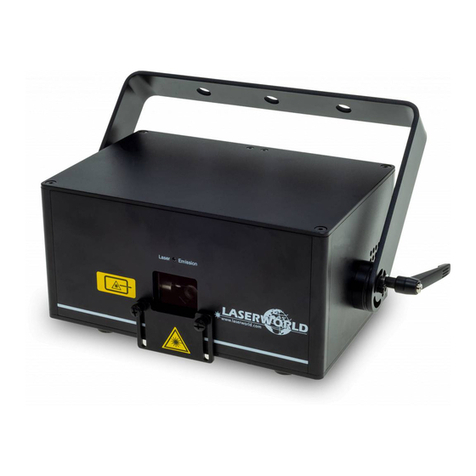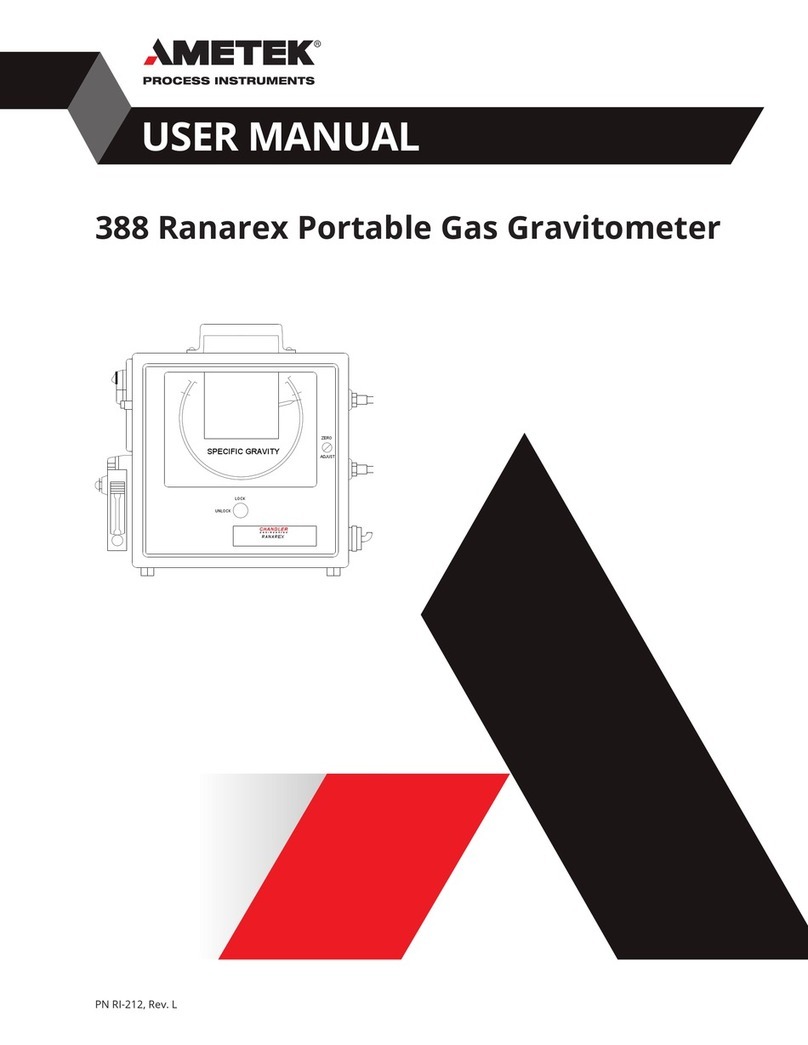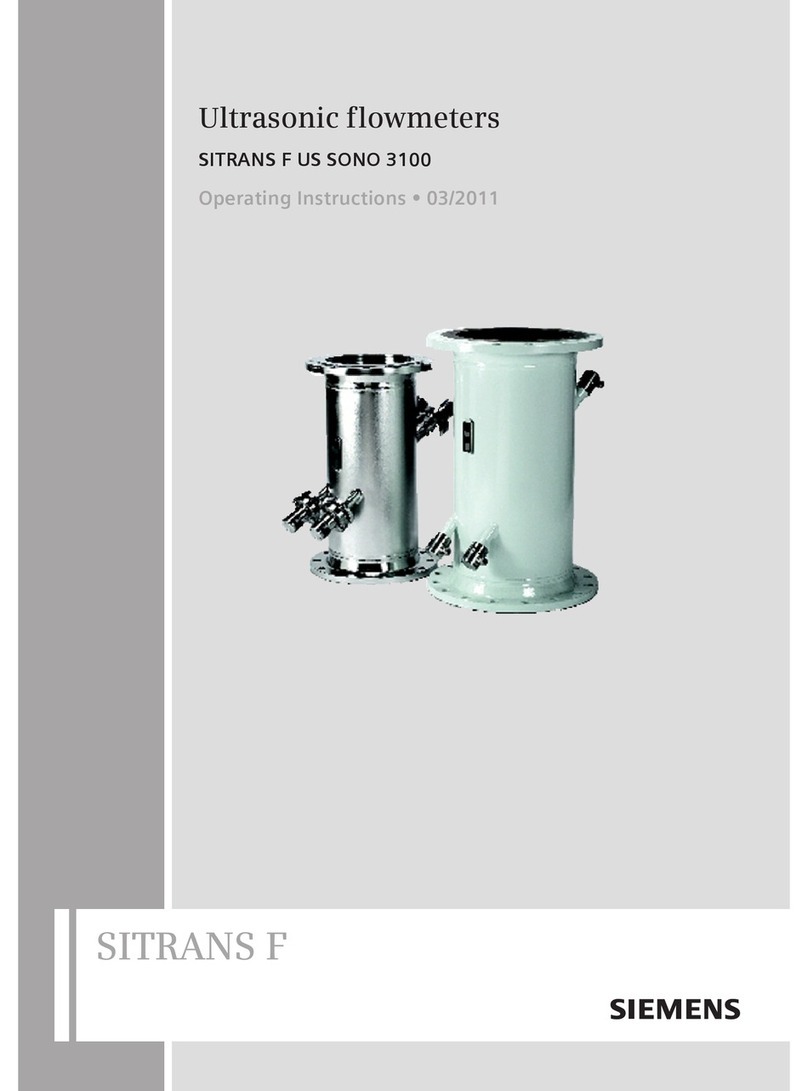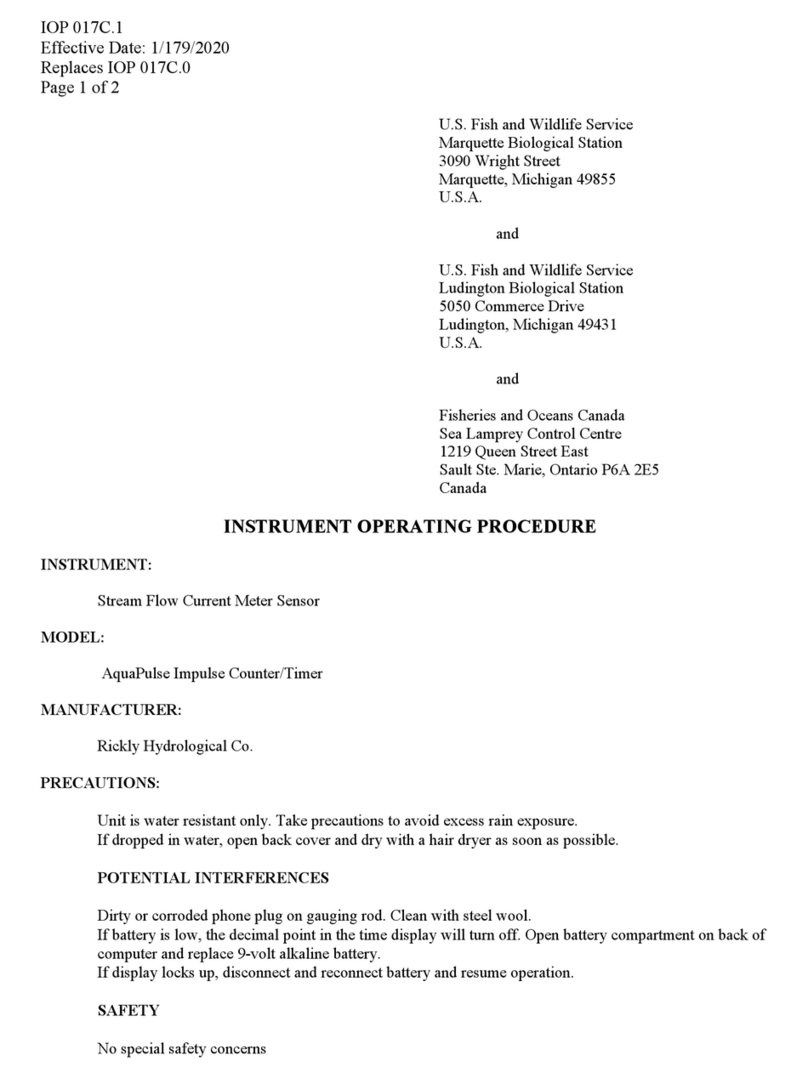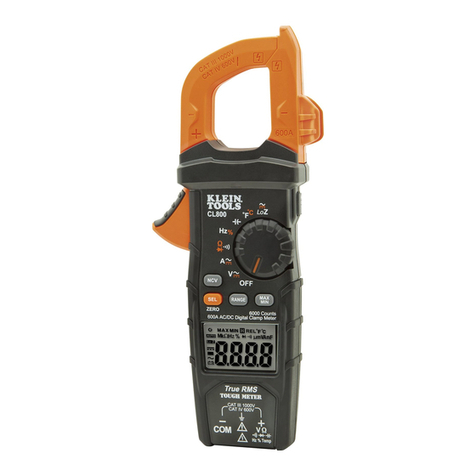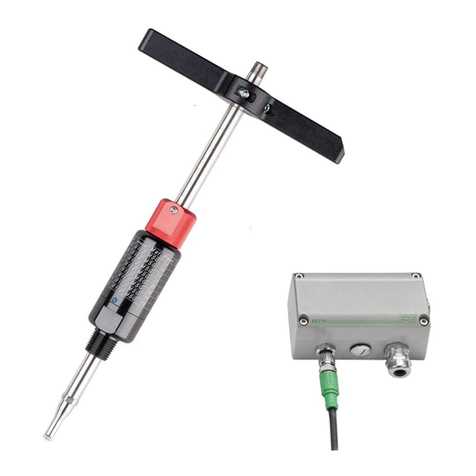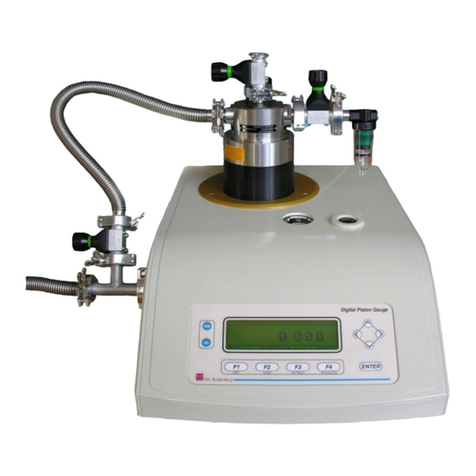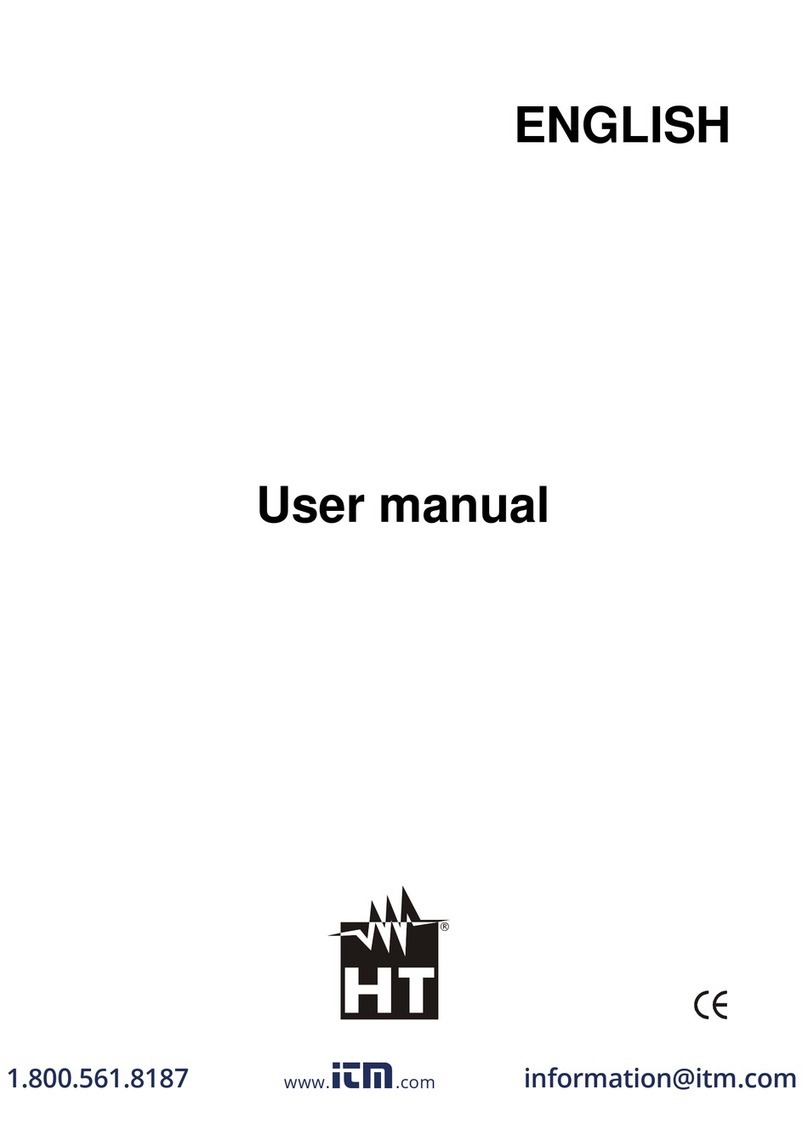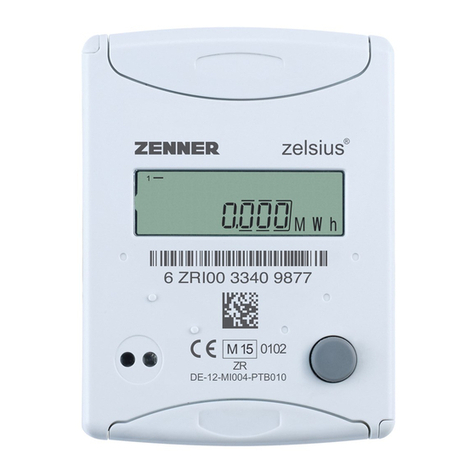MessKonzept FTC320 Ex User manual

FTC320 Ex
Gas analysis using thermal
conductivity measurement for
zone 2 ATEX II 3G Ex nR IIC T4 Gc
Operating Manual

Page 1 of 47
About this manual
Thank you for using the Messkonzept FTC320. It has been designed and manufactured using the high-
est quality standards to give you trouble-free and accurate measurements.
© Copyright Messkonzept GmbH 2023.
This document is protected by copyright. Neither the whole nor any part of it or the information
contained in it may be adapted or reproduced in any form except with the prior written approval of
Messkonzept.
All information of technical nature and particulars of the product and its use (including the information
in this manual) are given by Messkonzept in good faith. However, it is acknowledged that there may be
errors or omissions in this manual. Images and drawings may not be in scale. For the latest revisions
to this manual contact Messkonzept or visit www.messkonzept.de.
Messkonzept welcomes comments and suggestions relating to the product and this manual.
Please Note! The design of this instrument is subject to continuous development and improvement.
Consequently, this instrument may incorporate minor changes in detail from information contained in
this manual.
Important! In correspondence concerning this instrument, please specify the model and serial number
as given on the label on the right side of the instrument.
All correspondence should be addressed to:
Messkonzept GmbH
Niedwiesenstr. 33
60431 Frankfurt
Germany
Tel: +49(0)69 53056444
Fax: +49(0) 69 53056445
email: info@messkonzept.de
http: www.messkonzept.de
This manual applies to: FTC320
Date of Release: July 19, 2023
File name:
FTC320Ex Operating Manual_1.09KD201009MPO3V04.pdf

Page 2 of 47
Quick Installation Guide
For quick installation of the FTC320 we recommend reading the following chapters of this manual:
• Chapter 1 "Operator Safety": Important warnings, safety instructions and intended use.
• Chapter 3 "Assembly of the Instrument": Mounting, pneumatic and electric connection. Also see
Chapter 10 "Appendix: Dimensional Drawing"
• Section 7.1 "Calibration": Recommended calibration intervals, the calibration process and rec-
ommended test of functionality after bringing into service.
File name:
FTC320Ex Operating Manual_1.09KD201009MPO3V04.pdf

Page 3 of 47
Contents
1 Operator Safety 5
1.1 Notes on Safety Conventions and Icons . . . . . . . . . . . . . . . . . . . . . . . . . . . 5
1.2 Safety instructions for use in explosion hazard areas Zone 2 . . . . . . . . . . . . . . . . 6
1.3 Intended Use . . . . . . . . . . . . . . . . . . . . . . . . . . . . . . . . . . . . . . . . . 6
2 Principle of Measurement 8
2.1 Determining Concentrations via Thermal Conductivity . . . . . . . . . . . . . . . . . . . 8
2.2 FTC320 Detector Unit . . . . . . . . . . . . . . . . . . . . . . . . . . . . . . . . . . . . . 11
3 Assembly of the Instrument 12
3.1 Installation of the FTC320 . . . . . . . . . . . . . . . . . . . . . . . . . . . . . . . . . . . 12
3.2 GasPorts ........................................... 13
3.3 Leakage Test . . . . . . . . . . . . . . . . . . . . . . . . . . . . . . . . . . . . . . . . . 13
3.3.1 Housing Seal . . . . . . . . . . . . . . . . . . . . . . . . . . . . . . . . . . . . . 13
3.4 Electrical Connectors and Ground . . . . . . . . . . . . . . . . . . . . . . . . . . . . . . 13
3.4.1 Requirements for Electrical Connectors . . . . . . . . . . . . . . . . . . . . . . . 14
3.4.2 Ground......................................... 14
3.4.3 Data exchange via serial interface (RS-232) . . . . . . . . . . . . . . . . . . . . . 15
4 The Front Panel 16
4.1 Display............................................. 17
4.2 Keys .............................................. 17
5 Instrument display 18
5.1 warmup Screen . . . . . . . . . . . . . . . . . . . . . . . . . . . . . . . . . . . . . . . . 18
5.2 Operation Screen . . . . . . . . . . . . . . . . . . . . . . . . . . . . . . . . . . . . . . . 18
5.2.1 Display of one measured value . . . . . . . . . . . . . . . . . . . . . . . . . . . . 19
5.2.2 Display of several measured values . . . . . . . . . . . . . . . . . . . . . . . . . 19
6 General instrument settings 20
6.1 Top Level Main Menu . . . . . . . . . . . . . . . . . . . . . . . . . . . . . . . . . . . . . 20
6.2 Diagnosis ........................................... 20
6.2.1 Parameter Menu . . . . . . . . . . . . . . . . . . . . . . . . . . . . . . . . . . . . 21
6.2.2 Errors ......................................... 21
6.3 Instrument Setup . . . . . . . . . . . . . . . . . . . . . . . . . . . . . . . . . . . . . . . 22
6.3.1 Display Unit . . . . . . . . . . . . . . . . . . . . . . . . . . . . . . . . . . . . . . 22
6.3.2 Response Time Setup . . . . . . . . . . . . . . . . . . . . . . . . . . . . . . . . 22
6.4 Output Setup . . . . . . . . . . . . . . . . . . . . . . . . . . . . . . . . . . . . . . . . . 23
File name:
FTC320Ex Operating Manual_1.09KD201009MPO3V04.pdf

Page 4 of 47
6.4.1 Current Output Setup . . . . . . . . . . . . . . . . . . . . . . . . . . . . . . . . . 23
6.4.2 Voltage Output Setup . . . . . . . . . . . . . . . . . . . . . . . . . . . . . . . . . 26
6.5 Expert Setup . . . . . . . . . . . . . . . . . . . . . . . . . . . . . . . . . . . . . . . . . . 28
6.5.1 Parameter . . . . . . . . . . . . . . . . . . . . . . . . . . . . . . . . . . . . . . . 29
6.5.2 Access Modes . . . . . . . . . . . . . . . . . . . . . . . . . . . . . . . . . . . . . 30
6.5.3 Reset Functions . . . . . . . . . . . . . . . . . . . . . . . . . . . . . . . . . . . . 30
6.5.4 Test of Relays, Analog Outputs and Connections . . . . . . . . . . . . . . . . . . 31
7 Measurand related settings 33
7.1 Calibration . . . . . . . . . . . . . . . . . . . . . . . . . . . . . . . . . . . . . . . . . . . 33
7.1.1 Calibration gas purities and flooding time . . . . . . . . . . . . . . . . . . . . . . 34
7.1.2 Use of Substitute Gases . . . . . . . . . . . . . . . . . . . . . . . . . . . . . . . 34
7.1.3 Set Offset Gas Concentration . . . . . . . . . . . . . . . . . . . . . . . . . . . . . 35
7.1.4 Set Gain Gas Concentration . . . . . . . . . . . . . . . . . . . . . . . . . . . . . 35
7.1.5 Offset Calibration . . . . . . . . . . . . . . . . . . . . . . . . . . . . . . . . . . . 35
7.1.6 Gain Calibration . . . . . . . . . . . . . . . . . . . . . . . . . . . . . . . . . . . . 36
7.2 Mapping of Analog Output . . . . . . . . . . . . . . . . . . . . . . . . . . . . . . . . . . 36
7.3 AlarmSetup.......................................... 37
7.3.1 Selection of alarm groups . . . . . . . . . . . . . . . . . . . . . . . . . . . . . . . 37
8 Appendix: System Errors 39
9 Appendix: Specifications 42
9.1 Specification of Thermal Conductivity Measurement . . . . . . . . . . . . . . . . . . . . 42
9.2 Electrical Specifications . . . . . . . . . . . . . . . . . . . . . . . . . . . . . . . . . . . . 43
9.3 Permissible Conditions of the sample to be measured . . . . . . . . . . . . . . . . . . . 44
9.4 Environmental conditions . . . . . . . . . . . . . . . . . . . . . . . . . . . . . . . . . . . 44
9.5 Dimensions .......................................... 45
10 Appendix: Dimensional Drawing 46
File name:
FTC320Ex Operating Manual_1.09KD201009MPO3V04.pdf

Page 5 of 47
Chapter 1
Operator Safety
This section provides information and warnings which must be followed to ensure safe operation and
retain the instrument in safe condition. Read this section carefully before installing the device and using
the software.
1.1 Notes on Safety Conventions and Icons
draws attention to application errors or actions that can lead to safety risks, including
injury to persons or malfunctions - possibly even destruction of the device.
This icon indicates an additional function or hint.
Startup Safety Notes
• For the safe operation of the device, please pay attention to all instructions and warn-
ings in this manual.
• Start operating the device only after it has been installed properly. A competent and
authorized person is required for installation, connection, and operation of the device.
Please read and follow this manual for the installation.
• Defective devices must be disconnected from the process! This applies for apparent
damage to the device, such as physical damage, but also in the case of unclarified
malfunctions in the operation. Separate the device from the process pneumatically
(both gas inlet and gas outlet) and remove the power supply from the device.
• Make sure that the electric installation protection against accidental contact adheres
to the applicable safety regulations.
• Pay regard to the local regulations and circumstances regarding electrical installa-
tions.
• Repairs should only be carried out by Messkonzept.
File name:
FTC320Ex Operating Manual_1.09KD201009MPO3V04.pdf

Page 6 of 47
1.2 Safety instructions for use in explosion hazard areas Zone 2
Conformity with DIN EN 60079-15 "Explosive atmospheres - Part 15: Equipment protection by type of
protection "n" : 2011-02 and 2020-03" was proven with report no. 2.12BR190104AUG2V06 "Bericht
zur Eignung des Standardgehäuses der Messgeräte FTC3xx und FTC4xx für Zone 2, Schutzart „nR“,
schwadensicheres Betriebsmittel"1. If flammable gas is fed into the analyzer at overpressure, a leak in
the gas path could result in an ignitable mixture in the analyzer housing. To prevent the formation of an
explosive atmosphere in the device itself even in the event of a leakage, the housing is internally filled
with glass beads which, due to their filling density, leave only a small free volume of about 0.15l in the
housing. Moreover, due to the small size of the glass beads, this free volume is fragmented into such
small sub-volumes that a flame cannot spread. Therefore the device may only be opened by the
manufacturer.
1.3 Intended Use
• Messkonzept GmbH does not assume any liability in case of improper handling of the measuring
device. Improper handling can cause hazards due to malfunction of the measuring device.
• The FTC-series of gas analyzers offer high-precision measurement and detection of non-corrosive,
dust-, condensate-, aerosol and oil mist-free gases (unless the design of the equipment is explic-
itly declared to be suitable for this purpose). Please contact info@messkonzept.de for detailed
information and solutions.
• The specifications listed in the appendix of these operating instructions reflect the conditions
under which the products described here may be operated. Individual requirements resulting
from the customer’s measuring task are determined and recorded with the Measuring Task
Questionnaire (German: Messaufgabe 2.01.1FB180619MPL1V007, English: Measuring Task
2.01.1FB180619MPL1V007). Requirements that are not specified by the customer in the ques-
tionnaire are not taken into account in the mandatory evaluation of the measuring task by Messkonzept
GmbH. In the evaluation of the measurement task by Messkonzept GmbH, it is also recorded
whether the measurement task can be carried out with the proposed devices. In addition, re-
strictions can be demanded by Messkonzept GmbH, which must then be implemented by the
customer. These restrictions can include, for example, special conditioning of the measuring
sample by filter measures and measuring gas coolers or specifications of the pressure and flow
rate ranges.
• FTC-series gas analyzers do not have a metrology marking in the sense of EU directive 2014/32/EU.
They can, therefore, also not be used in medical or pharmaceutical laboratory analyses or in the
manufacture of pharmaceuticals in pharmacies based on a doctor’s prescription.
• The device must not be used in hazardous areas of explosion protection. Only FTC320 measuring
instruments marked EX II 3G Ex nR IIC T4 Gc are suitable for use in ATEX- Zone 2.
•Flammable gases: Depending on the design, the measuring device is also suitable for the intro-
duction of flammable gases. Whether this is the case can be found in the device log under the
item "Glass bead filling". Measuring instruments with glass bead filling are also suitable for the
introduction of combustible gases. The interior of the housing is tightly filled with glass balls (Ø
1Report on the suitability of the standard housing of the FTC3xx and FTC4xx measuring instruments for Zone 2, protection
type "nR", steam-proof equipment
File name:
FTC320Ex Operating Manual_1.09KD201009MPO3V04.pdf

Page 7 of 47
0.6mm). Due to the dense filling with the inert material, the volume that can be filled by a gas
in the measuring device is reduced and segmented to such an extent that no explosive zone is
created in the measuring device even if there is a leak in the measuring gas path.
•Explosive gases: Our gas detectors are designed in such a way that gases introduced up to
temperature class T3 will not ignite if operated properly; the maximum surface temperature is be-
low 200 °C. Users of our gas detectors must always carry out an individual risk assessment before
such use, from which the necessary protective measures are to be derived and implemented. The
use of flame arresters as part of the individual concept for handling ignitable mixtures is strongly
recommended. If desired, we will be pleased to submit an individual offer to you if you require
flame arresters. Please use only devices with the glass bead filling option described above even
with this hazard.
• Check the function and tightness of our gas detectors, the connections and piping and the protec-
tive devices after installation and then at regular intervals during operation, especially in the event
of severe stresses, such as shocks, vibrations, and corrosive attacks from inside or outside. If you
detect or suspect a malfunction in one of our gas detectors or the protective device, immediately
disconnect the affected gas detector from the power supply and stop the gas supply immediately.
• The housing of the FTC320 must never be opened, in particular in case of devices filled with
glass beads. After opening, the necessary filling density is no longer given. The guarantee
becomes void if you open the housing of the FTC320.
• The device and cables must be effectively protected from damage and from UV light (protective
roof when installed outdoors).
• The gas path inside the device is free of oil and grease and suitable for applications with pure
oxygen ("Cleaned for Oxygen"). For such applications, contamination, such as that caused by
the introduction of not oil-free compressed air, must be avoided.
• The cables must be connected voltage-free. Do not disconnect while energized!
• Permissible ambient temperature (when used as intended): -5 to +50 °C.
• A fixed wall mounting must be provided. The device is only to be mounted in areas with low
mechanical hazards, such as analysis rooms, in other words, rooms in which no heavy work is
performed.In areas with high mechanical hazards, such as workshops, transport routes, produc-
tion facilities for heavy equipment or construction sites, etc., additional protection against external
damage is necessary, e.g., by means of a protective cabinet.
• The device may only be used in an area with pollution degree 1 (according to DIN 60664-1).
• Avoid accumulation of dust on the device! Regular inspection of the housing and cables with
regard to mechanical damage is mandatory. In atmospheres that strongly attack plastics, the
front foil must also be checked for cracks and discoloration, especially in the area of the buttons.
If damage occurs, the device must be taken out of operation and the manufacturer must be
contacted.
Note: Please keep this manual for future use.
File name:
FTC320Ex Operating Manual_1.09KD201009MPO3V04.pdf

Page 8 of 47
Chapter 2
Principle of Measurement
2.1 Determining Concentrations via Thermal Conductivity
Thermal Conductivity Detectors (TCD) have been used in the chemical industry since the 1920s as the
first process gas analyzers for the quantitative composition of gas mixtures. Every gas has a unique
heat conductivity that is governed by its molar mass and viscosity. The measurement is based on the
principle that the thermal conductivity of a gas mixture is dependent on the thermal conductivity of its
gas components and their fractional amounts in the mixture. Thus, the concentrations of different com-
ponents of a gas mixture can be calculated from thermal conductivity.
The main advantage of the TCD’s measurement principle compared with the widespread infrared anal-
ysis technique is that it is not limited to gases with a permanent dipole moment. It can identify noble
gases (He, Ar, Ne, etc.) as well as homonuclear gases such as H2and N2. Furthermore, it is robust
and cost effective.
The principle of thermal conductivity measurement works best if the analyzed gas components’ thermal
conductivity varies greatly. For TC measurement-based analysis, one of the following conditions must
be met:
• The mixture contains only two different gases (binary mixture), e.g., CO2in N2or H2in N2
• The thermal conductivity of two or more components is similar but different than that of the mea-
suring gas, e.g., measuring H2or He in a mixture of O2and N2(quasi binary mixture)
• The mixture contains more than two gases and the volumetric fractions of all but two components
(or component groups) are constant over time
• The mixture contains more than two gases, of which all but two components’ concentrations
can be determined through other measurement principles (as employed in the FTC400 through
cross-sensitivity compensation of IR- and TC-sensor information).
The thermal conductivity of gases rises with temperature and the slope of the increase
with temperature is different for different gases. Upon request, it can be checked whether
the temperature of heat sink and/or source should be changed in order to improve the
accuracy or to avoid cross-sensitivity effects.
Cross-sensitivity is the sensitivity of the measurement on other gases than the measured
component. Perturbation-sensitivity means the sensitivity of the measurement to other
influences than the gas-composition, e.g., the gas pressure.
File name:
FTC320Ex Operating Manual_1.09KD201009MPO3V04.pdf

Page 9 of 47
Gas Out
130˚C
60˚C
Gas In
Figure 2.1: Schematic drawing of thermal conductivity measurement. The sensor is comprised in the
stainless-steel block which is kept at a constant temperature.
The FTC320 contains a thermal conductivity sensor that analyzes the quantitative composition of gas
mixtures. The measurement is based on the heat transfer between a heat source and a heat sink.
The measuring gas is led through a stainless-steel block that is kept at a constant temperature of
63◦C (for most applications). The block temperature is stabilized using a control loop - it serves as
a heat sink of constant temperature. A micro mechanically manufactured membrane with a thin-film
resistor serves as a heat source. A control loop stabilizes the membrane temperature at 135◦C (for
most applications).
Above and below the membrane two small cavities are etched into the silicon. These cavities are filled
with measuring gas by diffusion. The surfaces opposite the membrane are thermally connected with
the heat sink. Through maintaining a constant temperature gradient between the two opposite surfaces,
the heat flow is dependent on the gas mixture’s thermal conductivity alone. Hence the voltage needed
to keep the membrane temperature constant is a reliable measure for the thermal conductivity of the
mixture and can be used further to determine the gas mixture’s composition.
File name:
FTC320Ex Operating Manual_1.09KD201009MPO3V04.pdf

Page 10 of 47
Mea-
suring
Gas
Carrier
Gas
Basic
range Smallest range
Smallest
suppressed
zero range
Multi Gas
Mode
H2O20% - 100% 0% - 0.5% 98% - 100% Yes
H2N2/ air 0% - 100% 0% - 0.5% 98% - 100% Yes
H2Ar 0% - 100% 0% - 0.4% 99% - 100% Yes
H2He 20% - 100% 20% - 40% 85% - 100% On
request
H2CH40% - 100% 0% - 0.5% 98% - 100% On
request
H2CO20% - 100% 0% - 0.5% 98% - 100% On
request
He N2/ air 0% - 100% 0% - 0.8% 97% - 100% Yes
He Ar 0% - 100% 0% - 0.5% 98% - 100% Yes
CO2N2/ air 0% - 100% 0% - 3% 96% - 100% Yes
CO2Ar 0% - 60% 0% - 10% - Yes
Ar N2/ air 0% - 100% 0% - 3% 96% - 100% Yes
Ar CO240% - 100% - 80% - 100% Yes
CH4N2/ air 0% - 100% 0% - 2% 96% - 100% Yes
CH4Ar 0% - 100% 0% - 1.5% 97% - 100% Yes
O2N20% - 100% 0% - 15% 85% - 100% Yes
O2Ar 0% - 100% 0% - 2% 97% - 100% Yes
N2Ar 0% - 100% 0% - 3% 97% - 100% Yes
N2CO20% - 100% 0% - 4% 96% - 100% On
request
NH3H20% - 100% 0% - 5% 95% - 100% On
request
CO2H20% - 100% 0% - 2% 99% - 100% On
request
SF6N2/ air 0% - 100% 0% - 2% 96% - 100% On
request
Table 2.1: Measuring ranges of typical gas compositions for analysis with the FTC320.
As mentioned in section 1.3, explosive gases should not be led into the device without
suitable protective measures. It is the responsibility of the user to prepare a risk assess-
ment and to derive suitable protective measures from it.
File name:
FTC320Ex Operating Manual_1.09KD201009MPO3V04.pdf

Page 11 of 47
For flammable gases, such as H2, CH4, etc., the use of a FTC320 with the option
“glass-beads filling“ is strongly recommended. If a mixture of a combustible gas with an
inert gas is present in a mixing ratio such that even adding any amount of air will not make
the mixture explosive, it is called totally inert. Totally inert gas mixtures may be introduced
into a FTC320 device without glass ball filling.
“Basic range“ is the largest possible measuring range and is set by default. The lineariza-
tion is performed over the basic range. The smallest measuring ranges at the beginning
and the end of the basic range are facilitated through specific calibration. The smallest
possible range between the basic range and the smallest ranges at the end beginning and
the end of the range can be estimated by linear interpolation.
The Multi Gas Mode (MGM) is a configuration that allows for the consecutive mea-
surement of different gas pairs. The gas pair can be switched through the control panel
or via the RS232-interface. Gas pairs labeled “Yes“ in Table 2.1 are commonly used. Gas
mixtures labelled “On request“ can also be implemented upon request.
2.2 FTC320 Detector Unit
The FTC320 is a highly precise and stable Thermal Conductivity Detector (TCD) that is designed for
use as a gas detector. The unit consists of a hermetically sealed pressure proof stainless-steel block
with a gas duct, which is suited for pressures up to 20 bar. Sample gas entering through the gas inlet
is guided to the micro-mechanical thermal conductivity sensor and further downstream to the outlet
port. The pneumatics are designed to minimize the influence of a changing gas flow. The operating
temperature of 63◦C is stabilized by a highly accurate PI control loop.
In order to avoid electrical interference on the measuring output, the high-performance analog adaption
circuit is directly mounted on top of the stainless-steel block. The Processor board digitizes the signal in
a 24bit A/D converter. The micro-controller performs all calculations, such as linearization, calibration,
and cross sensitivity compensation directly on the detector unit.
File name:
FTC320Ex Operating Manual_1.09KD201009MPO3V04.pdf

Page 12 of 47
Chapter 3
Assembly of the Instrument
3.1 Installation of the FTC320
The FTC320 is designed for wall fastening. The four mounting holes are shown in Figure 3.1. M4
cylinder head bolts are suitable. Please remember to keep additional space for adequate assembly of
gas hoses and cables (see Chapter 10 "Appendix: Dimensional Drawing" for more information).
6mm
52 mm
20 mm
26 mm
80 mm
65 mm
144 mm
132 mm 4.5mm
Figure 3.1: Mounting holes shown from the rear side of the housing.
If you are planning to lead flammable or toxic gases into the device, the device must be
installed in a well-ventilated area. All devices undergo a leakage test during production,
nevertheless a limited release of small gas quantities is possible.
File name:
FTC320Ex Operating Manual_1.09KD201009MPO3V04.pdf

Page 13 of 47
3.2 Gas Ports
On the bottom of the FTC320 housing two tubes with 6mm outer diameter for gas connection are lo-
cated. They are labeled with “GAS IN “ and “GAS OUT“.
For low requirements regarding gas tightness and resistance to pressure, the tubes can be used as
hose connectors. For permanent gas and pressure tightness compression fittings are recommended
(e.g. by “Swagelok“©).
After connecting the device, a leakage test should be performed (especially when working with flammable
and/or toxic gases).
3.3 Leakage Test
After connecting the gas pipes, a leakage check of the joints must be carried out, e.g. with foam-forming
agents (soap solution or leak detection spray). The test is to be carried out at an overpressure of at
least 1 bar or the pressure expected in operation (max. 3 bar abs.) if this is higher.
The internal gas path of every FTC320 for use in potentially explosive atmospheres is tested for leakage
during production at a pressure of 4 bar for a holding time of 30 minutes.
3.3.1 Housing Seal
The housing leakage test is performed as a routine test according to DIN EN 60079-15:2020-03, sec-
tion 12.2.2.1.2. The interior of the housing is filled with glass beads to minimize the internal free volume.
Therefore the device may only be opened by the manufacturer. Unauthorized opening will ren-
der the instrument unsuitable for use in zone 2. Regular replacement of the silicone seal is not
necessary, but it is recommended that the manufacturer checks the tightness of the housing every 5
years. If the unit is installed in atmospheres that are highly corrosive to plastics, it is recommended to
have the inspection carried out more frequently.
3.4 Electrical Connectors and Ground
1: Analog Input 1
2: Analog Output 2
3: Analog Reference
4: Digital Input (24V)
5: Ground pin 4
6: Analog Output 1
7: Analog Input 2
1: 0 (4) - 20mA,
isolated +
2: 0 (4) - 20mA,
isolated -
3: Ground
RS232
4: TxD
5: RxD 1: Relay 1 - A
2: Power Supply-GND
4: Power supply +24V
3: Relay 1 - B
7: Relay 3 - A
6: Relay 2 - B
5: Relay 2 - A
8: Relay 3 - B
AB C
Figure 3.2: Electrical connector pin assignments of the three connectors on the FTC320
The FTC320 has three plug connectors as shown in Figure 3.2. The cables (712, IP67) with molded
connector plug and a length of two meters (five meters available on request) are part of the purchased
File name:
FTC320Ex Operating Manual_1.09KD201009MPO3V04.pdf

Page 14 of 47
parts package. The cables have open ends. The cross-section of the conductors in cable A and C is
0,14mm2, for cable B 0,25mm2. Cable A is shipped with devices set up for analog output.
The protection class of the device is only effective with all cables attached. In case cable
A is not used, connector plug A must closed with an end fitting.
3.4.1 Requirements for Electrical Connectors
Before using the device make sure that the power supply is in accordance with the
specifications of the device and that all electric connections correspond to the information
given in this manual.
The FTC320 is a device of protection class III. For power supply a source with PELV specification (Pro-
tective Extra Low Voltage) according to EN 60204-1 must be used. See also Section 3.4.2 "Ground".
The potential-free relay contacts must also be monitored with a power supply unit with PELV specifica-
tion.
3.4.2 Ground
ERROR
MAINT REQ
POWER
power supply
PELV complying
with EN 60204-1
+24V GND
AB C
GAS OUT GAS IN
Figure 3.3: Grounding the FTC320
File name:
FTC320Ex Operating Manual_1.09KD201009MPO3V04.pdf

Page 15 of 47
To comply with EN 60204-1 and to ensure your device’s function, the device has to be installed such
that the power supply (PELV) is connected to protective earth (PE) with its ground conductor, see
Figure 3.3. The shielding of cables A, B and C should be connected to functional ground. Dependent
on the circumstances, gas inlet and gas outlet can be grounded in addition. Connections to the ground
should be made with short low-resistant cables of large diameter.
3.4.3 Data exchange via serial interface (RS-232)
The serial interface, often called UART (Universal Asynchronous Receiver Transmitter), is based on the
RS-232 standard. The point-to-point data transmission is carried out via the two TxD (Transmit Data)
and RxD (Receive Data) wires to be crossed with a common ground line (GND) for both devices. This
creates a bidirectional bus that allows full-duplex communication. The communication partners can
therefore send and receive data simultaneously.
Data transmission via UART is performed with a fixed data frame (UART frame). This frame must be
known to both communication partners. It consists of: A start bit, 5-9 data bits, an optional parity bit and
one or two stop bits. If a PC is connected to the analyzer, the necessary settings are typically identified
automatically. If this is not the case, the parameters can be set manually according to Table 9.2. (see
Section 9.1).
Only a few PCs are still delivered with a so-called COM port (serial RS-232 interface). To be able to
operate and program devices that have an RS-232 interface with computers without this, use of con-
verters from RS232 to USB is advised. The converters often have a 9-pin D-Sub connector as input,
but there are also converters with screw terminal connections.
The serial interface allows operation of the instrument and the display and storage of
measurement data with the SetApp program. More information and a link to download the
software can be found at www.messkonzept.de.
If you plan to develop or use your own software solutions for communication via the
RS-232 interface, you may need more detailed information on the available parameters...
etc. Please contact Messkonzept in this regard.
File name:
FTC320Ex Operating Manual_1.09KD201009MPO3V04.pdf

Page 16 of 47
Chapter 4
The Front Panel
A1 A2 Er
0.30
[%] H2/N2
ERROR
MAINT REQ
POWER
Process Alarm 2 Indicator
Process Alarm 1 Indicator
Error Indicator
Maintenance Indicator
Operation Indicator
Currently measured
gas concentration
Measurement Unit
[Vol%] or [ppm]
RIGHT / Selection Key
(Toggle MGM Mode) UP / Selection Key ENTER / Terminate Key
(Gas Selection in MGM-Mode)
Figure 4.1: Front view schematic of the FTC320 front panel
File name:
FTC320Ex Operating Manual_1.09KD201009MPO3V04.pdf

Page 17 of 47
4.1 Display
4.2 Keys
RIGHT / Selection Key
On the operation screen, the <RIGHT> key can be used to select one of the measured
variables displayed on the work screen. With the <ENTER> key the menu related to the
measured parameter can be called up, in which, for example, the calibration routine of the
parameter can be accessed.
The <RIGHT> key enables the operator to scroll through the various menu items of menus
and submenus. The currently selected menu item is marked by black background and is
called with the <ENTER> key.
In submenus requiring numerical inputs, the <RIGHT> key scrolls to the next digit and to
“ESC/OK“ at the end.
UP / Selection Key
In menus or submenus, the <UP> key quits the recent menu and brings you back to the
menu above and ultimately to the main menu.
To quit menus with an “ESC/OK“ option, select one of these fields with the <RIGHT> key
and confirm with <ENTER>.
In submenus requiring numerical inputs, the <UP> key changes the selected digit.
ENTER / Termination Key
The <ENTER> key calls the item that is marked as selected (selection is indicated through
black background highlighted text). Menu items are selected by the <RIGHT> key. In sub-
menus with an “ESC/OK“ option the <ENTER> key confirms the selection of “ESC“ or “OK“.
File name:
FTC320Ex Operating Manual_1.09KD201009MPO3V04.pdf

Page 18 of 47
Chapter 5
Instrument display
This chapter describes the device start-up routine. The warmup screen, see Figure 5.1, shows the
block temperature while the block warms up. After the warmup, the device switches to the operation
screen, see Figure 5.2. From the operation screen the main menu can be opened.
Note: To make device-specific settings on the device, it is necessary to enter an Expert code (preset to
222.0000).
5.1 warmup Screen
Warm Up
Set: 63.00 °C
Act: 58.30 °C
Figure 5.1: warmup screen of the FTC320
The warmup screen shows the current block temperature during warmup in the center of the screen
(see Figure above). The target value of the block temperature, 63 ◦C for the standard version or 70 ◦C
for the high temperature version, is shown in the bottom line of the screen.
Pressing the <UP> key during warmup switches directly to the operation screen and
activates the current loop. The displayed concentration value will not be precise until the
needed block temperature is reached.
5.2 Operation Screen
After warmup the operation screen is shown (see Figure above). Depending on the version of the
instrument, either one measured value or several measured values are displayed on the working screen.
From the operational screen the main menu can be opened using the <UP> key.
File name:
FTC320Ex Operating Manual_1.09KD201009MPO3V04.pdf

Page 19 of 47
5.2.1 Display of one measured value
2/N2
0.30
[%] H
Figure 5.2: FTC320 operation screen (one measured parameter)
In the center of the display the currently measured gas concentration is shown, the associated unit of
the measurement (ppm or Vol.%) is indicated in the bottom left corner of the operation screen. The
currently measured gas pair, e.g. “H2/N2“ for hydrogen in nitrogen, can be found in the bottom right
corner of the display. The display resolution in ppm is 1 ppm, the number of digits displayed in Vol.%
indication is adjusted according to your requirements upon shipment (can be changed manually in the
Expert mode, see Sections 6.3.1 and 6.5.1).
In the top display line status information may be shown: Alarms are indicated by “A1“ and “A2“, system
errors are indicated by “Er“. If the top display line is empty, there are no active alarm indications.
5.2.2 Display of several measured values
H22.58 %
CH428.10 %
CO216.87 %
N252.45 %
Figure 5.3: FTC320 operation screen (several measured parameters)
Each line of the display is assigned to a measured variable whose designation is shown on the left
side, for example "O2" for oxygen or Pr. for pressure (for devices with pressure sensor). The value of
the measured variable is shown next to it on the right. The associated units (Vol. %, ppm, bar, etc.)
are displayed on the right side of the display. When displayed in Vol.%, the number of decimal places
displayed can be selected (preset according to customer requirements, modification requires Expert
Mode, see Section 6.3.1).
File name:
FTC320Ex Operating Manual_1.09KD201009MPO3V04.pdf
This manual suits for next models
1
Table of contents
Other MessKonzept Measuring Instrument manuals
